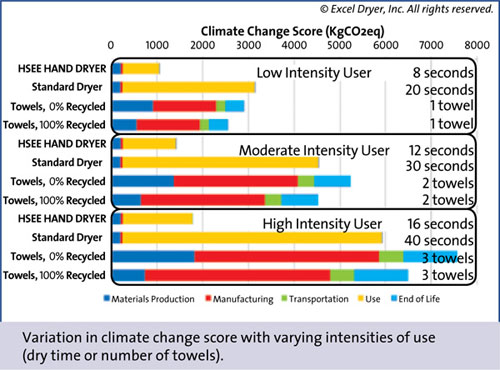Throw in the Towel: High-Speed, Energy-Efficient Hand Dryers Win Hands Down
Sensitivity Tests, Scenarios, and Uncertainty Assessment
For some of us, more answers inevitably lead to more questions. You may have more detailed questions, having gotten this new verifiable information. The LCA methodology addresses these even more specific issues using Scenario Evaluations, Sensitivity Tests, and peer-reviewers. You may be wondering about the impact of 0% vs. 100% recycled paper or renewable vs. fossil fuel energy generation or the heat given off by the electrical equipment.
Sensitivity Tests and Scenario Evaluations examine the responsiveness of the LCA results to varying conditions and explore the strength of the findings to alternate assumptions. Uncertainty Assessment - of the climate change impacts in this LCA - considers the range of measurement uncertainty in estimating the flows of material and energy in the systems and the uncertainty of the emission of pollutants or other impacts associated with each of these. The results of these efforts in this LCA "indicate that the differences among the three hand drying systems are quite significant, with the probability of the opposite conclusion being less than one in one million for the climate change score."
Recycled Content and its Allocation
The chart nearby shows the Climate Change Score improvement that can be attained by increasing the recycled content of the paper towels. Even with 100% recycled content the paper towel system remains 220% above the impacts of the HSEE hand dryer and remains above the conventional dryer as well.
The baseline scenario in this LCA for paper towels did not consider the impacts of forming recycled pulp from previously used paper products because of a lack of data of suitable quality to characterize the process. This, in effect, reduced the climate change impact for the process of recycling paper into pulp for new paper towels to zero for purposes of assessment. This choice errs on the side of underestimating the recycled towels impacts. But even when pulp processing is factored into the LCA using other scenarios, there is a "potential difference in the climate change score of up to 20%."

"However, the differences resulting from alternative approaches for allocating these impacts are [were] too small to change the findings of the comparison." In fact, a study of paper products in 2007 showed "a slightly higher impact on all indicators they report for paper washroom towels with recycled content." While this omission would not have altered the basic findings of this study, it does suggest further research would be useful regarding virgin vs. recycled content for paper towels.
Intensity of Use
The Intensity of Use is one of only a few user-driven variables that can affect the level of environmental impact for each system. The sensitivity test graphed on the chart nearby looked at the environmental benefits and impacts of extended or shorter drying times and multiple (or longer lengths of) towels. These multiple scenarios to gage the sensitivity of results based on the user's behavior. But even when a high intensity HSEE dryer user dries his hands longer time than normally required for completely dry hands, the HSEE dryer still has an environmental life cycle advantage over low intensity conventional dryer or paper towel users, i.e., someone who uses less time or paper and does not dry his hands. The chart nearby shows the largest variation for paper towel users - 300% - from one towel to three towels. But the impact of user intensity - from low to medium to high intensity - also increased for both hand dryers but by less than 100%.









